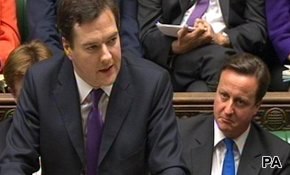YouGov president Peter Kellner discusses the public's reaction to news of Britain's worsening economy
The news for George Osborne continues to get worse. YouGov’s latest survey for the Sunday Times was conducted following the news that Britain’s economy contracted by 0.7% in the second quarter of this year – a worse figure than most economists had predicted. Even if, as I suggested last week, the final revised figures are not as bad as this, the pressure for the time being on the Chancellor is growing more intense. In our latest survey:
- Just 25% think the government is handling the economy well. This is the lowest figure we have yet recorded
- Only 19% now think Osborne should remain chancellor. As many as 52% want Cameron to replace him. More than one in four Conservative voters hold this view
- 45% now think ‘the government should change its strategy to concentrate on growth, even if this means the deficit stays longer or gets worse’. Just 28% want ‘the government to stick to its current strategy of reducing the deficit, even if this means growth remains slow’. This 17 point lead for Plan B over Plan A is the largest we have found
Were Osborne (or Cameron, should he be pondering whether to replace his Chancellor) wish to change direction, what should he do? We asked people whether they supported or opposed each of four different measures – three that involved borrowing more, and one to cut the deficit faster. These were the results.
Should the Government…
| Should% | Should not % | Net should | ||
|---|---|---|---|---|
Borrow more to boost infrastructure spending | 46 | 37 | +9 | |
Borrow more to cut taxes | 41 | 43 | -2 | |
Borrow more to reverse spending cuts | 32 | 48 | -16 | |
Reduce deficit faster by spending less | 24 | 60 | -36 | |
Want to receive Peter Kellner's commentaries by email? Subscribe here
As those figures show, none of the policies attracts majority support, and only one is backed by a plurality – borrowing more to boost spending on big infrastructure projects such as roads, rail and broadband. The public is evenly divided on borrowing more to cut taxes, but divide three-to-two against reversing the recent spending cuts if this causes borrowing to rise. Those three policies are variants of a Keynesian Plan B.
By far the most emphatic verdict is the towards the anti-Keynesian Plan B: reducing the deficit faster by cutting government spending faster. Voters reject this by five-to-two. When we analyse the data by party support, we find something unusual. Normally, supporters of different parties differ only modestly in their attitudes. Party members may hold vastly different views across the Left-Right divide, but there is generally a large overlap in the views of ordinary Labour and Tory voters.
However, on two of the four ‘Plan B’ options we tested, the gulf is huge:
Net scores by party
| Con | Lab | Lib Dem | |
|---|---|---|---|
Borrow more to boost infrastructure spending | +6 | +19 | +12 |
Borrow more to cut taxes | -24 | +12 | -39 |
Borrow more to reverse spending cuts | -72 | +33 | -29 |
Reduce deficit faster by spending less | +10 | -69 | -52 |
Views on infrastructure spending are broadly similar, with supporters of all three parties modestly in favour. On borrowing to cut taxes, Labour voters like the idea, while Conservative and Lib Dem voters generally against.
The real chasm emerges in views on the other two policies. Reversing the spending cuts is the most popular of the four policies among Labour supporters – and the most detested by Tories. In contrast, Conservative voters like the anti-Keynesian option – cutting spending and borrowing faster – more than any of the other three, while Labour voters regard it as anathema.
Lib Dem voters broadly agree with Labour voters in rejecting deeper spending cuts, but are even keener than the Tories in opposing tax cuts that add top borrowing. In fact the only Plan B policy that Lib Dem voters like, and then only by a narrow margin, is borrowing more to spend on infrastructure.
All that said, the pressure that is undoubtedly building up on Cameron and Osborne does not yet amount to a crisis. When we ask whom people trust more to run the economy, Cameron and Osborne, or their Labour shadows, Ed Miliband and Ed Balls, the Tory duo remain fractionally ahead, by 34% to 31%.
The two Eds can point to the fact that their 3-point deficit is their lowest yet. However, that argument flatters to deceive. This becomes clear if we compare this with the voting intention of the whole sample, not just those who choose a party when asked how they would vote. One third (33%) of the full sample say they would vote Tory – yet slightly more (34%) prefer Cameron and Osborne to run the economy. Labour enjoys 42% voting support among the full sample, but just 31% have more faith in the economic competence of the two Eds.
Bluntly, the economy still helps the Conservatives more than Labour. What we have seen since the Budget four months ago is their advantage diminish but not (yet) disappear. The Tories have reason to hope that an economic recovery between now and 2015 will revive their electoral prospects.
There is, though, a flip side to that analysis, and it’s bleaker for Cameron and Osborne. Suppose the economy recovers only slowly, or not at all. Suppose the clamour for Plan B becomes deafening. Suppose Britain’s swing voters turn decisively against the Government’s strategy and conclude that the two Eds were right all along to say the Government is cutting too far, too fast. If Labour can enjoy a sustained lead of around 10 points while (narrowly) LESS trusted than the Tories on the economy, how big could its lead grow if voters decide it is MORE trusted?
Want to receive Peter Kellner's commentaries by email? Subscribe here
See the survey details and full results for our latest Sunday Times poll









